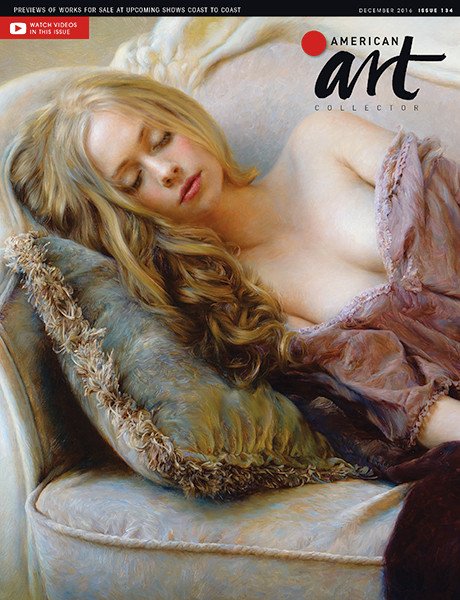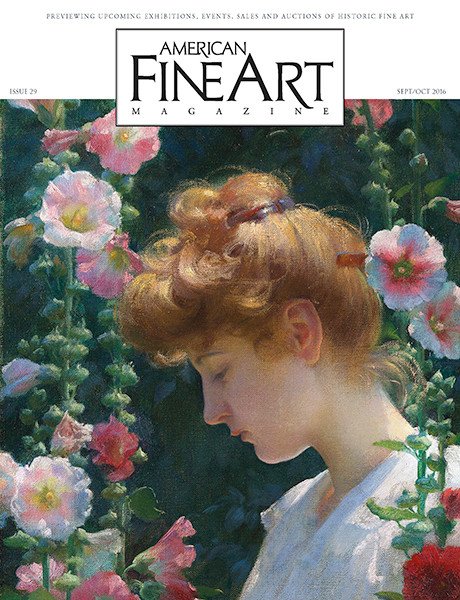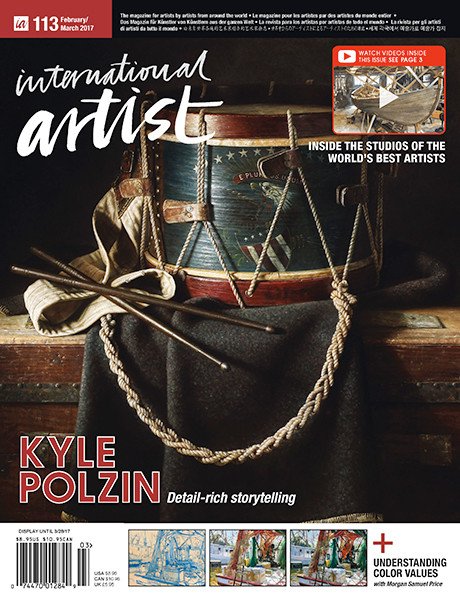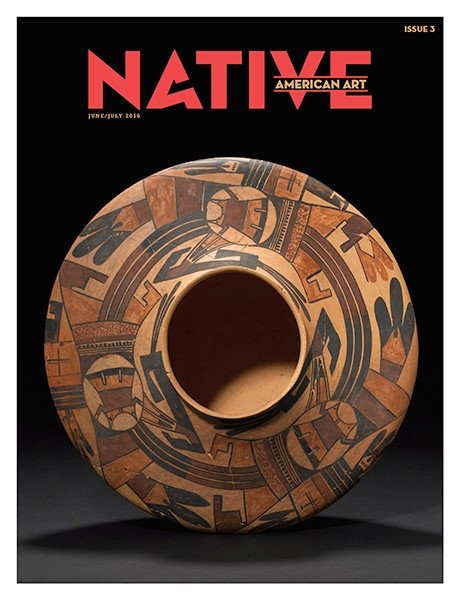In 2013, the Metropolitan Museum of Art presented the exhibition The American West in Bronze, 1850-1925. The exhibition, at one of the most prestigious art venues in the world, was a watershed moment for Western sculpture.
 Alexander Phimister Proctor with his Theodore Roosevelt monument.“The American West—imagined or real, past or present—is an ever-shifting, endlessly fascinating place. Our visions of the American West are often mediated through words and images—literature and the popular press, paintings and photographs, and of course film and television,” wrote Thomas P. Campbell, then the director of the museum, in the exhibition’s catalog. “Sculpture, too, and particularly the bronze statuette, has played a significant role in creating a perception of place and of time, often fixed in the Old West.”
Alexander Phimister Proctor with his Theodore Roosevelt monument.“The American West—imagined or real, past or present—is an ever-shifting, endlessly fascinating place. Our visions of the American West are often mediated through words and images—literature and the popular press, paintings and photographs, and of course film and television,” wrote Thomas P. Campbell, then the director of the museum, in the exhibition’s catalog. “Sculpture, too, and particularly the bronze statuette, has played a significant role in creating a perception of place and of time, often fixed in the Old West.”
For some fans of Western art, the exhibition offered a welcome feeling of validation and acceptance for an art form they loved. For others, there was another feeling: “About time!”
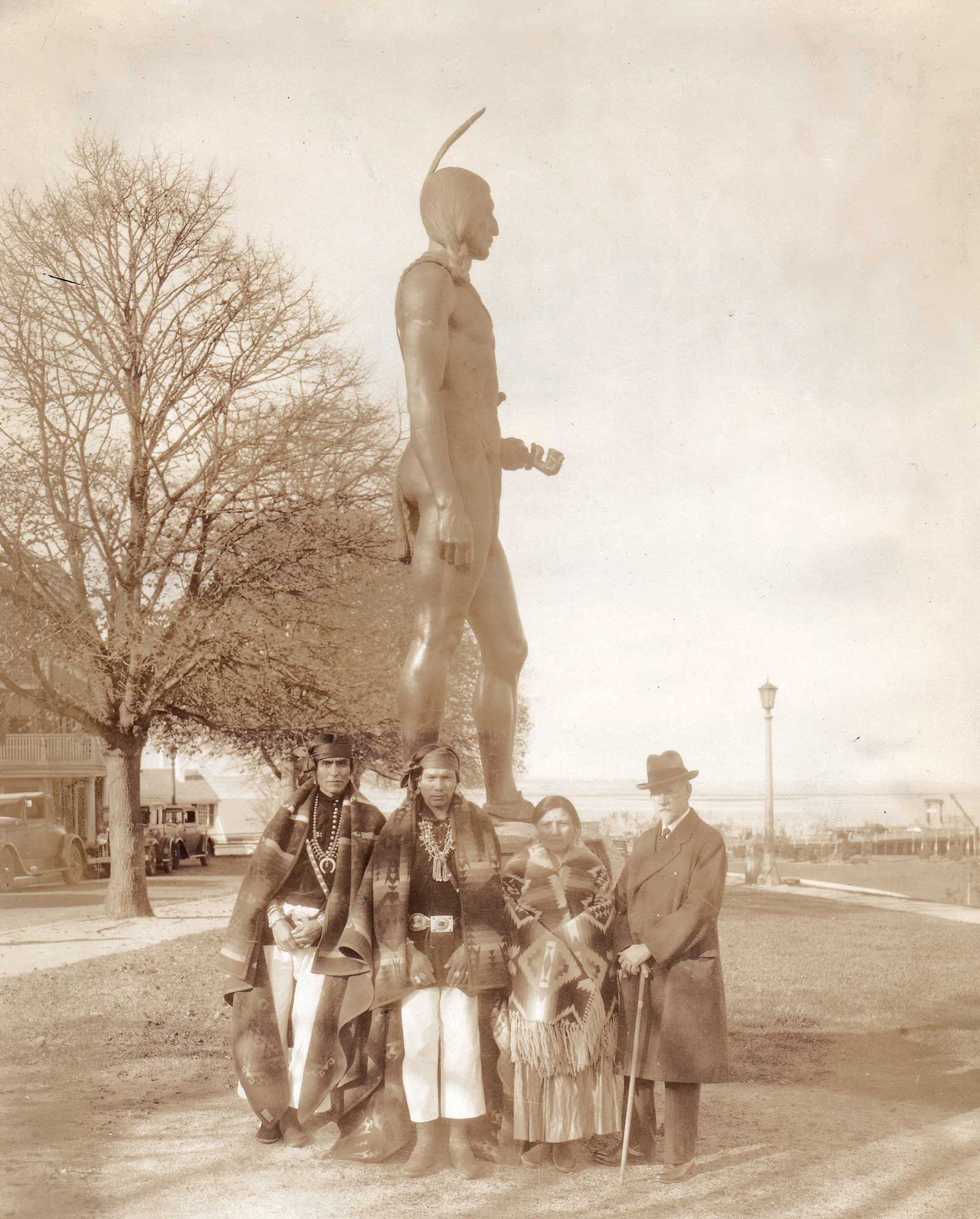
Cyrus Dallin and Navajo visitors stand in front of his sculpture (after 1921) of the Massasoit Ousamequin in Plymouth, Massachusetts. Courtesy Cyrus Dallin Art Museum.
Western sculpture has been around for a long time. Even as long as some of the earliest paintings. Consider works by John Quincy Adams Ward, Theodore Baur, Randolph Rogers and others that date back to the mid-19th century. Some of these artists were creating before Thomas Moran’s trips West, before Russell and Remington, and even before the introduction of the lost-wax casting process brought from Europe around 1900. (Prior to lost-wax casting, most artists and foundries were using sand castings.)
These early artists quickly began telling uniquely Western stories in bronze. And excelling at it, as was the case with sculptors such as Alexander Phimister Proctor and Cyrus Dallin, both of whom made iconic works—in sizes from small to monumental—that would entrance the public and draw interest to the American West. These artists quickly realized that history and purpose were popular attributes that resonated within their pieces.

Paul Manship (1885-1966), Indian Hunter and His Dog, 1926, bronze, 23¼ x 23½ x 7 in.
“I was born during the frontier period of the United States and grew up in Colorado in the best of it. It colored my life and influenced me greatly,” Proctor said. “I would not change my life for any other, but my love has always been divided. I am eternally obsessed with two deep desires—one, to spend as much time as possible in the wilderness, and the other, to accomplish something worthwhile in art.”
Early important pieces—Proctor’s Buckaroo, Dallin’s Appeal to the Great Spirit, Solon Borglum’s Lassoing Wild Horses—would speak to the wild nature of the West, its people, its creatures and that enduring myth that swirled around all of it. Even non-Western artists, like Paul Manship and others, were coming around to the themes of the West. The stories, the histories and the sense of adventure were not lost on viewers and collectors of this work.

Legacy Gallery, Victory! Plenty Coup, bronze, 29 x 13 x 8 in., by John Coleman.
Today the genre endures, and even flourishes. In this special section we take a look at Western sculpture of all kinds and celebrate the artists who are continuing this timeless tradition in the 21st century.
“When a boy living on the Long Meadow Ranch near Prescott, Arizona, it thrilled me watching my dad as a working cowboy,” says renowned sculptor and Cowboy Artists of America member Bill Nebeker.“That inspired my interest in horses, cattle, cowboys and ranching. Stories of local Yavapai tribal traditions and long ago raids on nearby ranches, settlers and stage stops developed my imagination about Native American culture, weapons and ceremonies. When I began sculpting working cowboys, cattle, horses, Old West outlaws, famous lawmen or Indigenous tribes, I wanted to bring life to the adventures, smells, action and emotions in my stories in bronze.” Many consider Nebeker to be among the very best sculptors of horses and cowboys alive today. “Working beside the cowhands on Arizona ranches, as the K4, Lobo, 7UP and historic ORO near Prescott is a privilege,” he adds. “Team roping with my cowboy friends at the Arizona Cowpunchers Reunion Rodeos is a great memory. These experiences give my sculptures authentic flavors of the Old West, as well as today’s contemporary ranching and livestock industries.”

Top: Legacy Gallery, Risky Bronze, bronze, 18 x 32 in., by Blair Buswell. Bottom: Bill Nebeker, Long Arm of the Law, bronze, 17 x 17 x 8 in. Bill Nebeker, Kwahadi Comanche, bronze, 14 x 16 x 8 in.
Esteemed Western sculptors Blair Buswell, John Coleman and Scott Rogers are all represented by Legacy Gallery in Scottsdale, Arizona. Blair has always been fascinated with the human figure. He likes the challenge of capturing the gesture, mood and expression of a person in thought, which brings a sense of life to his work. Buswell has also studied the skilled athlete in action and has used his artistic talents to sculpt famous sports figures of the day.

Coeur d’Alene Galleries, Morning Mayflies, bronze, 17½ x 14 in., by Ott Jones.
In Rogers’ own words, his lifelong fascination with renegades, outlaws, and stories of courage and freedom fuels his desire to use art to inspire others to appreciate the beauty of life in all its forms. “My desire is to use art as a vehicle, which inspires mankind to see the beauty of all life…Sculpture can be an instant conduit to a rich body of knowledge, [like] anatomy, feelings, history and lore.”
Coleman starts a sculpture with an emotional feeling, doing all his sketches in clay. At the later stage when he touches the clay with his tools, he is interacting with the material to create a feeling of life in the sculpture. He enjoys using symbolism, which has spiritual meaning in many cultures.

Bill Nebeker, The Wreck is On, bronze, 19 x 13 x 10 in. Dominique Boisjoli Fine Art, Story Totem Gnamma Hole, reclaimed steel, 50 x 9 x 2 in., by Chris Turri.
Dave Hodges’ time spent as an outfitter and guide during the early 1970s inspired the artist to create his 21-by-30-inch sculpture Trail Blazer. “This guide has already packed up the elk, but just in case he sees a shortcut out of the mountains, he is glassing to find the easiest way down,” Hodges explains of the piece. “The pack horse is wanting to be on the move and rubs his head against the lead horse. Some of my most enjoyable moments were spent, not hunting, but just watching the game animals go about their daily travels and learning their behavior. A good pair of binoculars was a must, as were a good horse and good pack animal.”

Top: Legacy Gallery, Roundup, bronze, 9 x 7 ½ x 4 in., by Scott Rogers. Coeur d’Alene Galleries, Moonlight Hunters, bronze, 27½ x 30 x 15 in., by Tim Shinabarger. Bottom: Dave Hodges, Trail Blazer, bronze, 21 x 30 x 7 in.
Coeur d’Alene Galleries owner Buddy Le says that bronze sculpture is the perfect complement to paintings in any art collection, adding that bronze is the most popular metal for casting sculptures because of its versatility and ease of casting. The material expands just before it sets, accentuating even the most minor details. “When purchasing bronze sculptures, pay attention to the artist inscription/signature, the edition number and total, and the foundry mark,” says Le. “These details can usually be found at the base of the bronze. When collecting historical bronzes, the foundry mark can be crucial to authenticating whether the cast is from the original edition. Like paintings, it’s crucial to put some good light on your bronze as well to really show off the details of the sculpture and the shadows the sculpture creates really enhances the viewing experience.”

Dominique Boisjoli Fine Art, Hanging Poolside, reclaimed steel, 67 in., by Chris Turri.

Dominique Boisjoli Fine Art, Desert Flower Forms, painted steel, 192 in., by Terrell Powell.
Dominique Boisjoli Fine Art is a gallery and sculpture garden located on the famed Canyon Road in Santa Fe, representing an array of Southwestern artists like Chris Turri and Terrell Powell. Working predominately with reclaimed automotive steel to render his series of totemic sculptures, Turri’s work is inspired by Indigenous symbolism and motifs of the Southwest. Powell’s brightly colored painted steel works draw inspiration from the surrounding New Mexican landscape in color, shape, line, pattern and markings. Terrell works spontaneously and relies on the subconscious or intuitive selection of images to guide his work. These two artists are joined by a deep roster of nearly two dozen additional artists working in a range of two- and three-dimensional mediums. Paintings, sculpture, ceramics and mixed media works are on view at the gallery daily and year round. —

Coeur d’Alene Galleries, The Goose Hunter, bronze, 47 x 32 x 13 in., by Keith McMasters.
Featured Artists & Galleries
Coeur d'Alene Galleries
213 E. Sherman Avenue, Coeur d'Alene, ID 83814
(208) 667-7732
www.cdagalleries.com
Dave Hodges
Hodges Fine Art Gallery
Big Timber, MT
(406) 932-6834
hodgesart@mtintouch.net
www.hodgesfineart.com
Dominique Boisjoli Fine Art
622 Canyon Road, Santa Fe, NM 87501
www.dominiqueboisjoli.com
Legacy Gallery
7178 Main Street, Scottsdale, AZ 85251
(480) 945-1113, www.legacygallery.com
Bill Nebeker
1830 Hereford Drive
Prescott, AZ 86305
(928) 445-7170, bronzes@billnebeker.com
www.billnebeker.com
Powered by Froala Editor
